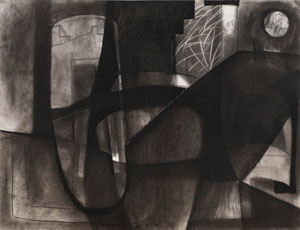7.25.25 — The Latin Third Person
Candida Alvarez had a habit of speaking of herself in the third person. She Loved to Dream, a title went. She Went Round and Round. She was that Girl Ironing Her Hair.
But who was she? That girl going round is multiplying her arms like an anatomical study or a deity. Maybe a true artist would aspire to both. That girl born to Puerto Rican parents in Brooklyn had to decide whether to iron her hair or to take pride in not being able to keep it straight. The dreamer may have wondered where to look to find her dreams. At El Museo del Barrio across from Mestre Didi, she may hardly know whether to look up close and personal or off into the distance to “Circle, Point, Hoop,” through August 3—and I bring this together with a recent report on Didi and Brazilian art as a longer review and 
Alvarez must have taken Socrates seriously when he asked followers to “know thyself,” but she could not have found it easy. Born in 1955, she came of age just when critically acclaimed artists were refusing to try. Remember the “Pictures generation“? They were making pictures, not confessions. They and others were putting painting and art institutions to the test. And then there was this kid from Vinegar Hill near Dumbo, a child of the projects, not so near the action but unable to let go.
She could speak, too, in the first person. Identity was newly part of the picture, too, for women of color in the arts, and she had a breakthrough in 1989 with Soy Boricua, “I am a Puerto Rican American.” Inset to the upper left of a seeming abstraction is a child, black skinned and wide eyed. Look again and that image, after a family photo, becomes a larger portrait’s left eye, a dark color her left, more colorful passages her hips. She asked to know abstract painting and not just black abstraction inside and out. She made all the right moves and got her MFA at Yale in 1997.
That painting is one in a series of diptychs, one panel above the other. Colors change abruptly across the edge, and acrylic stains sink right in and shine right out. So do bright reds speckled with thicker paint, for She Wore Red to the Senior Prom. Elsewhere Alvarez gives up color completely in favor of black or shadowy grays dotted with white. She is out to connect the dots. As her brush curves freely across the surface, she is also speaking through symbols, and who knows what they represent?
In truth, she has no firm set of symbols, just an urge to let painting speak for itself. She experiments with Flashe, the rubber based paint, and a weave so thick that her canvas might be a net for the unwary. It is also her “air painting” and a way of letting light pass through. She is always improvisational, with smears on the surface and kitchen graters here and there on the floor. She calls an early series her hybrids, and never mind if you cannot say hybrids of what. As yet another title has it, Wish Me Luck.
She finds an anchor throughout in modern art. Body fragments evoke Surrealism, while Minimalism returns in black and white. Sparer paintings with the grain of wood as ground recall Paul Klee, Max Ernst, and Sophie Taeuber-Arp. The show’s title work recalls the modern mantra of point, line, and plane. Still, she is the Puerto Rican telling stories and the New Yorker heading for the prom. She appeared before at the Whitney in “Puerto Rican art after Hurricane Maria,” and it is all Nueva York.
Not that Alvarez appears all that much. She herself may find it hard to follow Socrates, and her frequent shifts make it hard to pin her down. The curators, Rodrigo Moura and Zuna Maza with Alexia Arrizurieta, proceed more or less chronologically and by series, but the attempt defeats even them. Still, both her stories and her colors keep their shine. Mary in the Sky with Diamonds pays tribute to her mother-in-law, and the barbs in her circle of string, nails, gouache, and wood still have their bite. In a collision of cultures, she could know herself, family, and the Beatles.
Read more, now in a feature-length article on this site.
